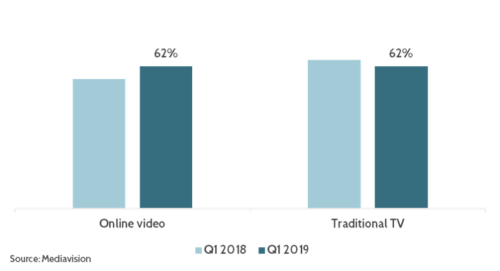Daily reach for online video and traditional TV now on par in Sweden
Wednesday, April 24th, 2019Daily reach for online video and traditional TV now on par
The soon to be released Q1 analysis of the Video Market in Sweden from Mediavision, reveals that online and traditional viewing now is on par in terms of daily reach. This is an important milestone, but of even greater importance is the overall effect that online viewing has had on the market.
In Q1 2019, the migration of consumers from traditional TV to online reached a new milestone in Sweden, with online and broadcast daily reach both at 62%. Online viewing has grown rapidly in recent years while broadcast is plumbing. What happens beyond this point, may be even more exciting. Online growth is slowing down, indicating a maturing market. Consequently, actors are faced with new challenges – such as an increased focus on customer retention and viewing time.

At the same time, there are movements in the market that indicate further online growth. With several new “giants” entering the streaming market this year, it wouldn’t be surprising if online reach were to get a new push. For instance, a lot has been said about Disney’s streaming service Disney+ and its focus on attracting new customers through exclusive content. And with an increasing number of households subscribing to SVOD services (so called “buy through” B-SVOD) via operators, this could also boost daily online reach to the next level.
While on the subject of Disney, the company recently revealed that its new SVOD service will be priced at $6.99 per month, which is significantly lower than market leading Netflix. The service is set to launch on November 12th in the US. Furthermore, Disney appears to be taking a “quality over quantity” approach. At launch, Disney+ will offer roughly 7500 episodes and 500 movies in its library, which corresponds to approximately 16% of Netflix’ current US catalog.
Latest News
- Netflix posts first quarter 2024 results and outlook
- Graham Media Group selects Bitmovin Playback
- Dialog, Axiata Group, Bharti Airtel agree on merger in Sri Lanka
- Yahoo brings identity solutions to CTV
- Plex has largest FAST line-up with 1,112 channels
- TV3 migrates from on-prem servers to AWS Cloud with Redge